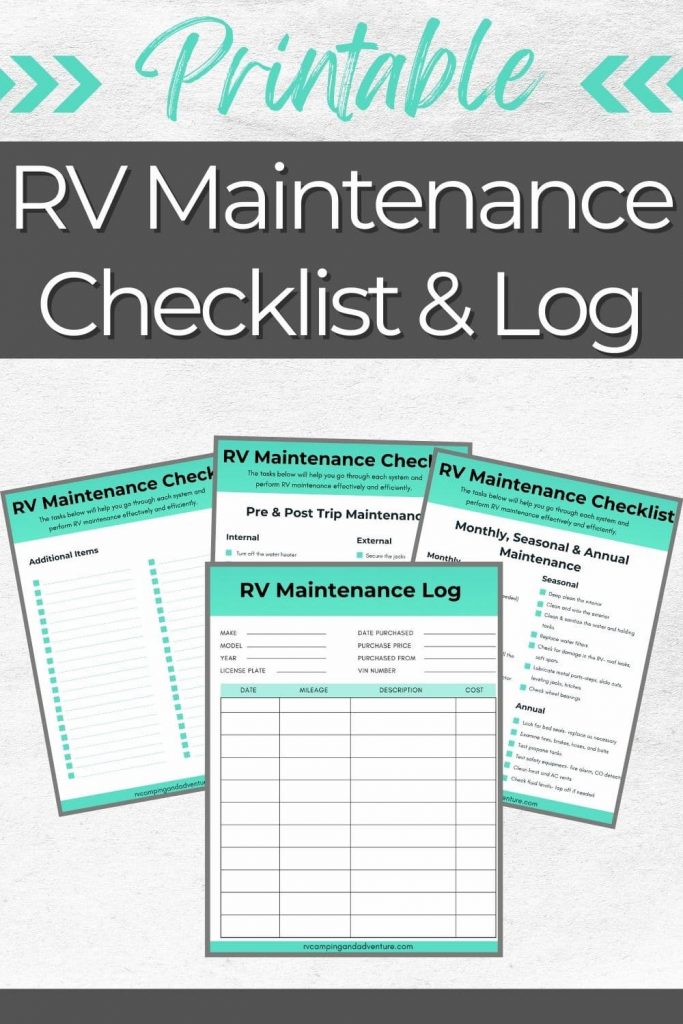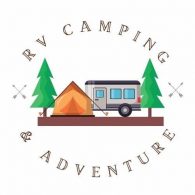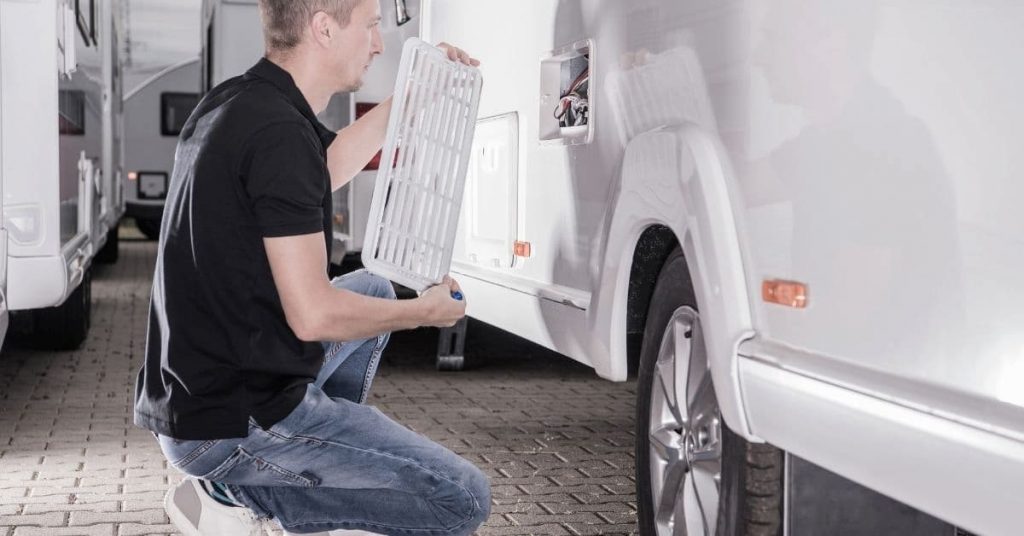Whether you have a new RV or have had yours for a few years, keeping it in optimum condition will ensure that you will have safe and enjoyable camping trips for years to come. So, if you’re looking for the best way to stay on top of everything without feeling overwhelmed, here is an RV maintenance checklist that can help you get started.

Free RV Maintenance Checklist & Log
Sign up below to get a free printable RV maintenance checklist and a maintenance log that can help you stay organized and keep your camper in tip-top shape!
Easy RV Maintenance Schedule
Whether your camper is used often or just taken out once or twice a year, a good inspection and RV maintenance are always a good idea.
Since routine maintenance is essential, we have included an RV maintenance checklist for before and after trips, monthly maintenance, and even a seasonal maintenance checklist so you can make sure everything is in tip-top shape!
Let’s get started with a visual inspection of the interior and exterior that is great for before and after each trip.
Pre And Post Trip Maintenance Tips
Checking for problems before and after each camping trip might sound tiring but a properly maintained camper will definitely save you time and money over time as well as ensure safety.
Let’s get started with RV maintenance!
Internal Checkups
In the interior of your RV or travel trailer, here are a few maintenance tasks you will want to do before leaving and after your trip when you return home.
1. Water Pump Turned Off
Whether you’re ready to hit the road or getting ready to store your RV for a while, it is important to make sure that the water pump for the fresh water tank is turned off.
2. Water Heater Turned Off
Your RV’s water heater must be shut off before you start to drive or before storing for any amount of time. If the water heater isn’t being used, there’s no reason to have the heater on!
3. Furnace Turned Off
A common source of fire inside an RV is the furnace. Therefore, we recommend you to keep it off when not in use.
4. Turn Off the Fridge
Many states won’t allow using propane freezers inside a running RV. Also, like the furnace, why use propane to keep an appliance going when the camper isn’t being used?
5. Switch Off The Pilot Lights
While moving, pilot lights will not be necessary. You must keep them off to be on the safe side as they can also culminate in a fire hazard.
6. Test The Smoke Detector And Carbon Monoxide Detector
Testing smoke alarms and carbon monoxide detectors is so important for safety! Even with the best maintenance, a fire could occur or a leak could happen.
So be sure to check these two alarms, and don’t forget to have a fire extinguisher and a first aid kit in your camper too!
7. Put Down the TV Antenna
If you have an antenna be sure to fold it down before you leave.
8. Check All Windows, Doors, and Cabinets
Before you start driving, make sure that all the doors, windows, and cabinets are locked and secured.
9. Keep the Shower Closed
You must close the shower doors properly, as they can swing open if not shut tight.
If there are bathroom accessories, ensure they are stowed properly too.
10. Empty And Secure Trash Cans
A moving vehicle will make the trash can fall or move from place to place, so before you head out, be sure to empty any trash and secure the cans.
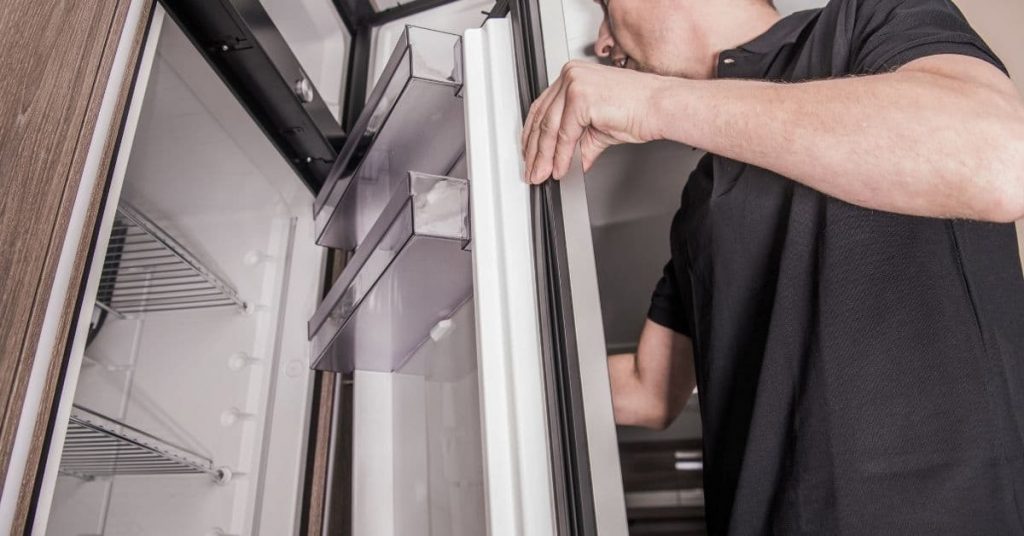
External Checks
Ok, so we’ve gone over the interior checklist, let’s go over everything to inspect the exterior of your camper.
1. Secure The Jacks
RV jacks might fall off while you are driving. So, to stop it from happening, it’s important to keep them secured in a raised position.
Always look for potential corrosion, split metals, and loose ends on the jacks.
2. Remove The Chocks
If you are using chocks, be sure to remove them and stow them in a secured position before you drive.
3. Check All Lights
To make sure all beams, signal lights, brake lights, and fog lights are working properly and there are no loose connections, flip the necessary switches and step on the pedals to make sure they are functional.
If the cable connections seem loose or you notice the pedal doesn’t feel quite right when you push on it, be sure to take it to your mechanic to service brakes and check the electrical system.
4. Inspect The RV Tires
Remove the tire covers, then examine the tires thoroughly. Check to see if each one has the recommended tire pressure, and do a visual inspection of its overall condition.
You’ll want to make sure that there are no nails or screws in the tread, each tire has all necessary lug nuts (and they’re tight), and they seem to wear evenly.
Don’t forget to check the spare tire too!
5. Secure the Awning
Securing the awning is really, really important! If you drive with an awning that isn’t secured properly you risk losing the awning, damage to your fifth wheel or camper, or even damaging someone else’s vehicle if the awning rips off while you’re driving.
(We have seen this up close and personal while going over the Mackinac Bridge. An unsecured awning went through the window of the truck in front of us!)
6. Shut Off All Heaters
Just like the interior check, you must make sure that water and gas heaters are completely off before driving or put in storage for the winter.
7. Store Outdoor Accessories
If you’re going camping or just coming back, chances are you will have outdoor chairs, foldable tables, a portable grill, and maybe even a camping cabinet that will need to be secured.
These are helpful (and sometimes expensive) items so be sure to secure them before taking off!
8. Put Down Satellite Antenna
If you are using a TV inside the RV, make sure to slide down the antenna to a resting position before starting the vehicle.
9. Dump Tanks & Secure Hoses
Before you leave a campground, it is essential to empty the water system and dump the holding tanks. The RV’s sewer hose must be properly cleaned and stowed as well.
10. Unplug Any Electrical Cords
If you’re connected to electricity, whether in a campground or at your home, you will need to unplug any and all electrical cords before leaving on your trip or storing your camper for a time.
11. External Compartments and Steps
Make sure all compartments are securely closed and locked, the entry door is shut tight, and fold the exterior stairs up before leaving.
12. Clean Up the Camp Site
This is a really important, but sometimes overlooked part of camping- leave a pristine campsite.
Look out for trash and debris and dump them to maintain a clean-looking site.
This may not be exactly RV maintenance, but leaving no trace is something all campers need to do 😉
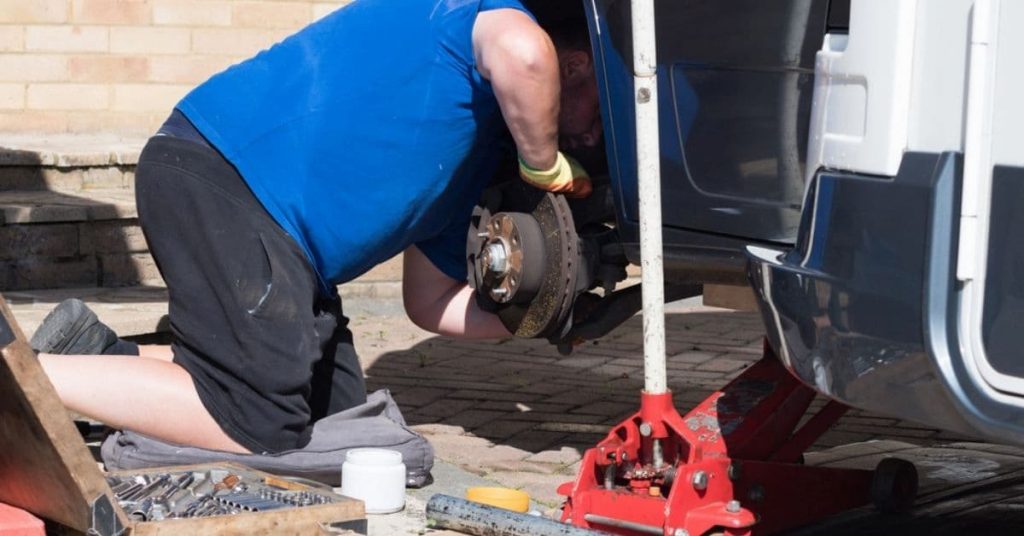
Monthly RV Maintenance Tips
It is not unusual for RVs to sit unused for months. That’s why it is essential that RV owners perform monthly checks and routine maintenance.
1. Check and Repair Seals
Check all interior and exterior seals on the roof, doors, and windows.
Good seals play a crucial part in limiting water leaks and preventing water damage that is so common in travel trailers.
2. Check Battery Water Level
With time the RV battery water will evaporate and vanish. If you have this type of battery, be sure to top off the water level with distilled water to ensure that it works optimally.
3. Start The Generator
If the generator has not been in use for a lengthy period, then there is a chance that the gasoline will not be good. To avoid this, you can add a fuel stabilizer along with running the generator at 50% capacity for at least two hours each month.
4. Clean Air Conditioning Vents
An RV’s air conditioner provides nice, cool air inside the RV. If the vents are clogged, the AC won’t work properly and impaired units can have high repair costs.
So, to counter this issue, use a vacuum to clean the vents every month and keep the air conditioning unit in good health.
5. Check the RV’s Engine
Engine maintenance is a crucial part of vehicle maintenance tasks. You, the RV owner, must look at the engine for potential leaks and along with making sure the clamps and hoses are attached properly.
The best way to maintain a well-balanced engine is to run the vehicle for a short distance every month.
6. Top Off All Fluid Levels
The engine oil, transmission fluid, antifreeze, and windshield wiper fluids might drop below normal as time goes by.
If sitting idle for long, you may have to add fluids. So don’t forget to give these a quick check as you go down your RV maintenance checklist.
7. Gather The Toolbox
An emergency toolbox is needed for every RV owner.
You never know what complications you might face on the road. So, having a toolbox with spare parts along with necessary tools and extra fluids can be a lifesaver.
8. Check The Smoke Detectors
Carbon monoxide and smoke detectors inside RV are essential!
But, you must check the batteries regularly and test them to make sure they are working properly.
Be sure to change the batteries every six months too!
9. Keep Pests Out
If the RV is not in use for a while, it could turn out to be a shelter for unwanted critters.
To counter this problem, make sure all doors and windows are closed tightly, there are no gaps in the siding, and there is no cracked insulation underneath so those little creatures can’t get in.
If you need help making sure your RV is secure, check out this article about how to keep mice out of your camper.
10. Inspect Moisture Seals
Always look for cracks or bubbles on exterior sealants. Moisture can wreak havoc, so you can use RV sealants to prevent and repair cracks.
11. Lubricate the Slideouts
Last but not least, make sure the RV slide-outs are well lubricated. The hinges, latches, and other parts must be working smoothly, so lubricating them adequately is the best way to keep them functioning.
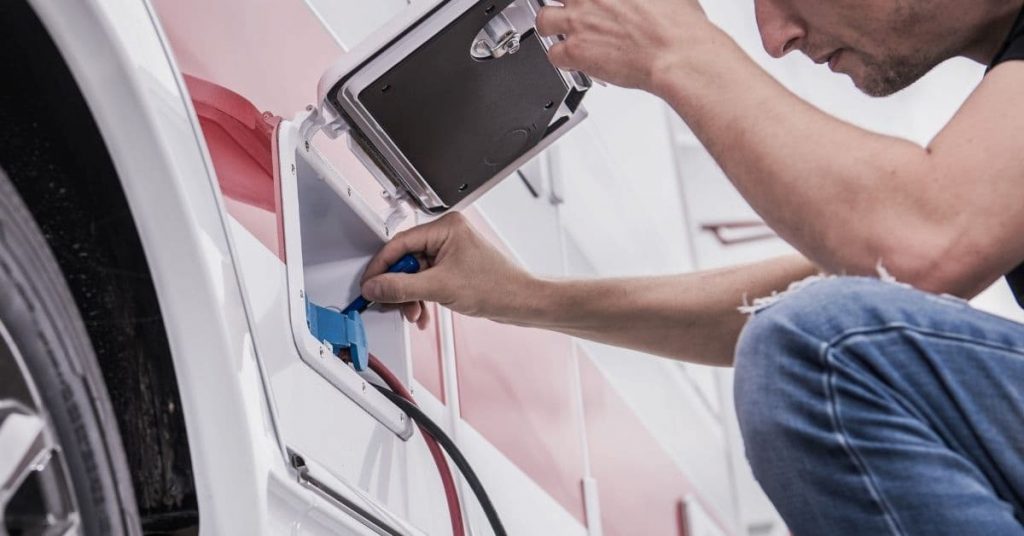
Seasonal RV Maintenance Tips
There are a few aspects of maintenance that don’t need to be looked after every day or month. You can simply have it checked every six months or so to keep things in good working order. Let’s look at some basics….
1. Deep Cleaning the Interior
Performing a deep clean on the interior will help keep your RV clean, smelling fresh, and keep little creatures out.
For best results, give your camper a deep cleaning every six months with lighter cleanings in between.
2. Wash And Wax The Exterior
To keep your travel trailer or RV looking nice and keep it protected, it’s a good idea to wax the exterior once or twice a year.
3. Clean Tanks & Replace Water Filters
Even though most campgrounds have potable water, in order to have water that tastes good and is free from contaminants, it is almost always necessary to have a water filter.
If used often or left unused for an extended period, it will be necessary to change your filter.
Another important chore is to add to your RV maintenance checklist is to make sure you clean and sanitize the water tank and fresh water hose.
Be sure to clean the tanks and then replace your water filter though so the whole system is fresh and clean!
4. Damage Check
RVs sitting for a long period, even the running ones, may still suffer from water damage, broken seals, or other issues.
Harsh weather can wreak havoc on a camper.
So, be sure to look for any broken seals, cracks on the RV roof, or wet spots.
If you find one, apply sealants to secure it so that no pests or water can enter the interior.
5. Lubricate Metal Parts
Metal joints are common on the steps, slideout, leveling jacks, hitches, etc.
These places are likely to get corroded easily so take a little time to make sure these are properly lubricated.
This can save time, money, and reduce the chance of problems down the road.
6. Check Wheel Bearings
To make your RV roll down the road smoothly, you may need to check the wheel bearings. If you need help be sure to ask your mechanic to give them a look when taking it in for service.
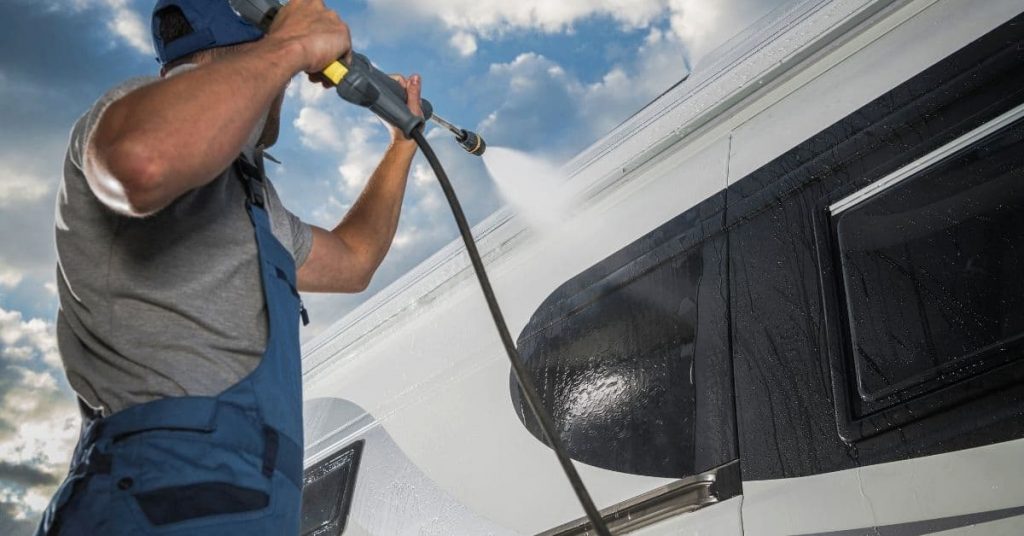
Yearly RV Maintenance Tips
In addition to regular maintenance and monthly checkups, your RV will need yearly maintenance as well. It is similar to the monthly list, but there are a few other things you need to consider.
Let’s have a look…..
1. Look For Bad Seals
We have already talked about taking a good look at the seals on an RV. Now, during the camping season, it’s not unusual to just patch things or get along until you’re not using the camper, but during a yearly inspection, a bad seal really should be replaced.
This is important because proper sealants keep the RV roof and windows secure so no water (or bugs!) get in and cause damage.
2. Examine Tires, Brakes, Hoses, and Belts
Like any vehicle, it is typically advised that you have the tires, brakes, hoses, and belts serviced by a professional yearly unless you are very familiar with doing this type of work yourself.
If you have a vehicle that you tow behind a motorhome, be sure to inspect these parts, rotate the tires, and check for safety issues on this vehicle as well.
3. Test The Propane Tanks
Check for leaks in your RV’s propane system.
You’ll want to look for connection issues, paint damage, and dents.
Also, be sure to check over the hoses and seals to see if there are potential gaps that can lead to a propane leak.
4. Test Safety Equipment
The smoke detector battery and carbon monoxide alarm battery will wear out in time. That’s why it’s best if you replace the batteries at least once per year (every six months is better though!).
Don’t forget to check the safety equipment after installing new batteries to make sure it works properly.
5. Clean The Cooling and Heating System
Just like when you service and clean your air conditioning vent every month, you must perform this task yearly as well.
Also, be sure to check over the heating system.
Make sure that the vents are cleaned, the thermostat works properly, and there are no leaks.
6. Fluid Levels
Rechecking the fluid level on RV batteries, transmission, radiator, and engines every year is a good idea.
A yearly inspection is a great time to change the oil, replace a battery that’s wearing out, or fix any leaks that were not taken care of earlier.
7. Keep Your Maintenance Log Updated
Having an annual maintenance log helps you keep track of the service and maintenance of your RV.
If anything is due, you can have it checked accordingly.
This will not only help you keep on top of maintenance but if you ever decide to sell the new owners will be grateful to see what has been done and how well you’ve cared for the RV.
So be sure to always update the log once you’ve performed any maintenance.

Don’t Forget To Grab Your Free Printable Checklist & Maintenance Log!
Frequently Asked Questions
Have a few questions related to RV maintenance? We’ll try to answer a few common ones we’re asked here…
1. Are RVs hard to maintain?
RV maintenance isn’t necessarily hard, but it does take time and there are costs involved. But, that’s why a good maintenance checklist is so important. It can help you save time, stay organized, and stay on top of RV maintenance so you can have a well-cared-for camper and that usually means less costly repairs.
2. How often should an RV be serviced?
Your owner’s manual should give a recommendation for this so that is what you will want to follow. Typically, though, it is recommended that RVs be serviced every 3-6 months.
If you can’t or don’t want to service your camper every few months, at least be sure to give it a thorough check once per year.
3. How often should I start my RV while it’s in storage?
If you have a motorhome, camper van, converted school bus, or any type of recreational vehicle with a motor, it is usually recommended that you start it at least once a month and let it run for a few minutes.
If you can, taking it out for a short drive would be helpful. If that’s not possible, starting it every month will still be helpful.
Last Thoughts…..
Following the RV maintenance checklist will not only keep your RV looking and running well, but can also help you stay organized and alert to any small issues before they become bigger problems.
So, give your RV a good once over before you hit the road and you can enjoy your trip with the knowledge that you are safe and secure.
Related Articles
- Learn Everything You Need To Know About RV Antifreeze (Before Winter!)
- RV Covers: Pros, Cons & Best Options
- RV Tire Covers: Are They Necessary?
- How To Quickly & Easily Sanitize An RV Water Tank
- 9 Easy Ways To Keep Outdoor Rugs From Blowing Away
- The Ultimate Camping Planner: A Must-Have Printable Planner For Your Next Adventure
Looking for more helpful RV tips? Check out the RV Basics page to find tips, tricks, and must-have info!
